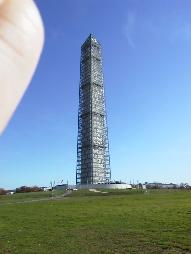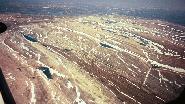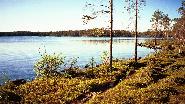More Junkmail from Bob!
Monday, August 7, 2000Important Stuff.
Believe it or not, there has now been one year of Bob's Junkmail. And I still refuse to proofread!
For a web-based version, click here.
Office for $10
On Ebay and other online auctions you can find Microsoft software for sale at cheap prices. Most of these are copies people no longer use, but an increasing number are illegal copies. Microsoft is hunting down the software pirates. Microsoft even wrote a search engine to find illegal copies of its products for sale. When asked what he thought of the software pirates selling illegal copies of his software, Bill Gates responded, "Resistance is futile. They will be assimilated."
http://www.msnbc.com/news/440645.asp
Fire!
There are a bunch of forest fires all over the Western U.S. I heard on the radio that there are more fires now than there have been in the past dozen years. Let's see... fire... hot air... Wasn't there a Bush running for president 12 years ago?
Actually, a lot of the fires were started by lightning. Ben Franklin felt lucky one day and decided to find out if lightning was made of electricity. He flew a kite with a key on the string, got a shock, and decided that it was in fact electricity.
Now people are finding out it's more than electricity. STEPS 2000 was a big research project this summer on Thunderstorms. It stands for Severe Thunderstorm Electrification and Precipitation Study. This summer, from May 17 to July 20, people from several universities and government labs got together to study big thunderstorms around Goodland, KS. Here is a summary of what they found.
N10WX
On June 29, Tom Root was out flying a T-28. Here's a picture of it.
He happened into some bad weather. He encountered a strong updraft -- more than 6000 feet per minute! That's about a 70 mph wind, blowing UPWARD. After he got out of the thunderstorm, he turned around and headed back in. 5 times. He found "Heavy rain, moderate hail and continuous lightning," and I'm betting there was some serious turbulence too although the report didn't mention it. Just before landing at Goodland, KS, the engine seized. He made it OK though. He was flying through a storm for STEPS 2000.
Normally, I regard large thunderstorms as probable death when I'm flying. Tom flies through them for a living. He flies a T-28 operated by the South Dakota School of Mines and Technology. The T-28 was developed in the 1940's as an air force trainer. The one Tom flies is a little bit special, just like his flights. It has about 700 lbs. of armor for protection from hailstones, metal grates over the engine and radiators, and lots of other modifications even before you start talking about the research instrumentation.
When they were designing the modifications for this plane, they decided icing wouldn't be much of a consideration because it was so overpowered and there is so much supercooled water in a thunderstorm that de-icing equipment wouldn't help a whole lot. They picked a piston plane because hail and lightning are hard on turbines. It's kind of funny -- lightning damage to turbine engines in turboprops is fairly common. The lightning just seems to end up in the engine and burn a hole in a blade.
Here is a page describing the plane:
http://www.ias.sdsmt.edu/institute/t28/plane.htm
Here are some photos of the plane from Tom Warner's web site:
http://www.sharonandtom.com/aviation/T28.html
...and here are some great pictures from his web site:
http://www.sharonandtom.com/photography/framesportfolio.htm
The plane is very impressive. There are hail dents everywhere. As you might expect, the plane gets hit by lightning a lot. Usually it's not very bad because the plane isn't grounded and doesn't make a very strong target. The biggest problem for the plane is turbulence and icing. Icing tends to shut down the engine, either partially or fully. They have collected an inch of ice per minute on the plane before when flying through a storm. One thing you might not expect is that this plane has been flying through thunderstorms since the 1970's (unless you cheated and read the web page above).
Here's the journal entry for STEPS on June 29:
"June 29: Well this was the event we have all been hoping for, and we got it! A tremendous supercell storm was in the east Doppler lobe for over two hours. Observations included excellent Doppler coverage by CHILL and S-Pol (great coordination on scans), four EFM launches, T-28 penetrations, excellent coverage by the mobile mesonet (with observations of a tornado) and supporting soundings measurements. LMA reported flash rates of 1 per second at times.
"One particular highlight was the fact that the storm became a right mover near Wheeler around 2330 UTC. This behavior was accompanied by the onset of positive CG's and the occurrence of a tornado. The first tornado observation was noted around 2330 UTC, az/range of 57 degrees, 75 km from CHILL (reported by NSSL5). Prior to this time the storm produced only one positive CG, and was primarily an intracloud lightning producer. The storm was reported as having an inverted polarity structure prior to the turning and onset of positive CG's.
"Near 2350 UTC, the storm featured a well-identified BWER with tops to 15 km. Ldr values as large as -15 db in the hail shaft. Reflectivites of 60 dBZ were maintained to 10 km AGL for a good deal of the time the storm was in the east lobe.
"First EFM was launched near Wheeler into the mesocyclone. NSSL5 was then directed south and east and ended up setting up for further launches near Brewster KS. Second EFM launch was 3 mi. west of Brewster, again into mesocyclone. Third EFM was also into mesocyclone near 0045 UTC at Edson, KS. The fourth EFM was sent up into a strong core that was just north of I-70, with was north of the main core that the previous EFM's had been launched into. This storm was targeted since it was producing positive CG's and had a mesocyclone. If NNSL5 would have stuck with the southern storm that they had been working, they would have been directly in the path of the mesocyclone associated with the northern storm. This location was undesirable for obvious reasons, and hence the northern storm was selected. The Hailstone van set up near Brewster too, and got a great core penetration near 0030 UTC 30 June. There were numerous reports of hail exceeding golf ball size in this area. The manual hail catcher was used, but the software on the SDSMT hail box was not operative after several reboots.
"T-28 penetrations were conducted between roughly 2240 and 2340 UTC, 29 June. A total of 6 passes were made. Pass 4 and 6 were most interesting, with a peak updraft of 33 m/s on one of these passes. Heavy rain, moderate hail and continuous lightning were observed on these passes. Unfortunately the engine on the T-28 seized just before landing and the aircraft is down for the rest of STEPS. The aircraft was able to land at the Goodland airport, thanks to the tremendous skill of pilot Tom Root. We are all thankful that Tom made it back to Goodland safely. The T-28 provided 14 flights for STEPS and performed very well.
"The mobile mesonet got great observations including hail intercepts and a tornado siting.
Radar observations were ended around 0245 UTC 30 June, with CHILL examining the hailstorm as it moved off to the SE. To date this event marks the top case collected in STEPS. "
Here are the June 29 radar images. I think they'll be studying the data from this summer for quite a while.
More Lightning
In thunderstorms there is lots of lightning. It's common for a storm to have more than one lightning flash per second. You can check the national lightning map right now and problem find lots of lightning in the U.S., especially if it's in the afternoon or evening. This is a map of cloud to ground lightning. The red spots are the positive strikes, which are more common in severe storms.
Every year people get struck by lightning. There's 70%-90% chance of surviving a lightning strike, depending on who you ask. Even so, there are 75 to 150 deaths per year from lightning, usually more than tornadoes and hurricanes combined.
A couple of weeks ago, an 18-year old guy was walking around near the top of Pikes Peak, Colorado. He was struck by lightning and killed. According to the data, it looks like the first cloud to ground strike of the storm was the one that killed him. So if you're out mountain climbing and it just looks bad, you should probably get below the timberline. Afternoon thunderstorms in Colorado are the rule rather than the exception this time of year.
A week ago Sunday, the Washington Monument was opened for the first time in seven months. It has been undergoing renovations. You can see it in the background of this picture I took of my finger last November:

Last Wednesday they closed it again for a few days because lightning hit it and knocked out the elevator. I think it's open again now.
Lightning is associated tornadoes. Here's some optional reading on how lightning behaves before a tornado:
http://www.cira.colostate.edu/ramm/visit/icae99_tot_light_torn.htm
How likely is it that you'll be struck by lightning? Not very, although the odds are substantially better than winning the lottery. There is a less than a 2 in a million chance you'll die from lightning this year, assuming you are average. If you climb mountains, golf in Florida, or drive a tractor without a cab you can up the odds a bit.
Where is the best place to be struck by lightning? The top nine states to get hit by lightning, per population, are
|
Florida |
6.4 |
|
Colorado |
5.5 |
| Arkansas |
5.1 |
| West Virginia |
4 |
| Maine |
3.9 |
| Utah |
3.7 |
| New Mexico |
3.6 |
| North Dakota |
3.4 |
| Tennessee |
3.2 |
This is based on injuries and deaths combined, from 1990 to 1994, per million population. You can get all kinds of lightning injury statistics at
http://www.nssl.noaa.gov/~holle/techmemo-sr193.html
Faster than Light?
In last week's Junkmail I mentioned the experiment where a light pulse seemed to go faster than the speed of light. Phil Plait's Bad Astronomy Page has a good explanation of this that even I can understand:
http://www.badastronomy.com/bad/news/index.html
It's got a lot of other neat stuff, too.
Dotcom of the Week
In about 1994, Sanjay Amin started Entropy Systems. It's a company who claims to have an engine that runs off ambient heat. They say they've raised about $3.5 million from 49 investors, but they haven't quite built the engine yet. It sounds just a little too close to a perpetual motion machine to me. Some people who should know are of the opinion that their design does not completely abide by the laws of physics. This could be a problem, since there are very few exceptions to those laws.
Mr. Amin said he had a working prototype and would be delivering by early 2000. Now, he says that was premature and he will let everyone know when it is ready. In the meantime, he's started an e-book site is an e-book site where you can go to download books and read them free of charge. I don't think they're making money at the moment, either.
Details:
http://wired.com/news/technology/0,1282,37963-2,00.html
Better than Eros?
NASA and the Japanese space agency ISAS are teaming up to send a spacecraft to an asteroid, gather data, and return samples to earth. It will launch in 2002, meet the asteroid in 2005, and return to Earth in 2007, assuming they can agree on units of measurement.
http://www.jpl.nasa.gov/releases/2000/museschange.html
The Pictures of Today are from last summer.
Here is some of the most barren land you can imagine, in Northern Norway. It's almost solid rock, with very little soil or plants. The weather comes through strong in the winter and doesn't let much grow there.


This is about 75 miles away, near Kirkines, on the same day. There's a small mountain ridge dividing the two areas that holds out the weather.

The other picture of the day is a butterfly chowing down last Saturday:

(e) 2001, no rights observed. Any or all of this find piece of junk may be duplicated, distributed, copied, and ruminated without fear of political uprising, riots, or insurrection. Xpda.com is back on the air, even to viagrafix.net users, so if you would like to read the past year's worth of Junkmails, go to
http://xpda.com/junkmail
Then see a head doctor. You can also add yourself or anybody else with an email address to the Junklist there. If you would like to stop receiving Junkmail, change your email address, follow a rolling blackout, or take your laptop on an aerial cruise aboard N10WX.
Send any comments, questions, ideas, or spare quarters to bob@xpda.com. Send any criticism to Washington where it belongs (DC or State, either will be fine).